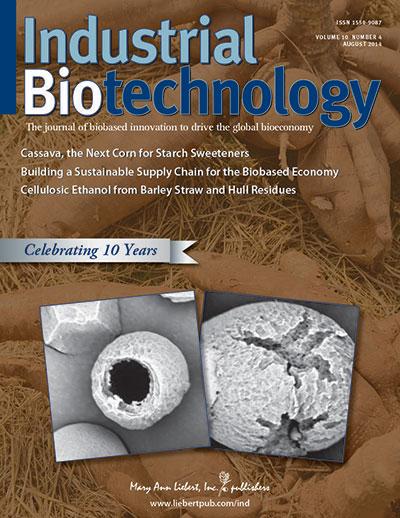Can tapioca replace corn as the main source for starch sweeteners?

Industrial Biotechnology, led by Co-Editors-in-Chief Larry Walker, PhD, and Glenn Nedwin, PhD, MoT, CEO and President, Taxon Biosciences, Tiburon, CA, is an authoritative journal focused on biobased industrial and environmental products and processes, published bimonthly in print and online. The Journal reports on the science, business, and policy developments of the emerging global bioeconomy, including biobased production of energy and fuels, chemicals, materials, and consumer goods. The articles published include critically reviewed original research in all related sciences (biology, biochemistry, chemical and process engineering, agriculture), in addition to expert commentary on current policy, funding, markets, business, legal issues, and science trends. Industrial Biotechnology offers the premier forum bridging basic research and R&D with later-stage commercialization for sustainable biobased industrial and environmental applications. Credit: © Mary Ann Liebert, Inc., publishers
With the availability of novel enzymes and processes designed to break down tapioca starch into sugars that can then be used to produce sweeteners such as glucose, fructose, or maltose syrup, tapioca may be an ideal alternative to corn, as described in a Review article in Industrial Biotechnology, a peer-reviewed journal from Mary Ann Liebert, Inc., publishers. The article is available for free on the Industrial Biotechnology website.
In the article “Cassava, the Next Corn for Starch Sweeteners”, Jay Shetty, DuPont Industrial Biosciences (Palo Alto, CA), Bruce Strohm, Grain Enzyme Technology (Beloit, WI), and Sung Ho Lee and David Bates, and Gang Duan, from DuPont Industrial Biosciences in Cedar Rapids, IA and Wuxi, China, respectively, describe the current geographic distribution of cassava cultivation, and the composition and utility of the starch that comprises 24-30% of the cassava tuber.
The authors discuss the variety of enzymes and processing steps available to convert tapioca starch to glucose via liquefaction and saccharification.
“Novel enzyme discovery and development continues to be core to expanding industrial biotechnology opportunities,” says Co-Editor-in-Chief Larry Walker, PhD, Professor, Biological & Environmental Engineering, Cornell University, Ithaca, NY.
About the Journal
Industrial Biotechnology, led by Co-Editors-in-Chief Larry Walker, PhD, and Glenn Nedwin, PhD, MoT, CEO and President, Taxon Biosciences, Tiburon, CA, is an authoritative journal focused on biobased industrial and environmental products and processes, published bimonthly in print and online. The Journal reports on the science, business, and policy developments of the emerging global bioeconomy, including biobased production of energy and fuels, chemicals, materials, and consumer goods. The articles published include critically reviewed original research in all related sciences (biology, biochemistry, chemical and process engineering, agriculture), in addition to expert commentary on current policy, funding, markets, business, legal issues, and science trends. Industrial Biotechnology offers the premier forum bridging basic research and R&D with later-stage commercialization for sustainable biobased industrial and environmental applications.
About the Publisher
Mary Ann Liebert, Inc., publishers is a privately held, fully integrated media company known for establishing authoritative peer-reviewed journals in many areas of science and biomedical research, including Environmental Engineering Science and Sustainability: The Journal of Record. Its biotechnology trade magazine, Genetic Engineering & Biotechnology News (GEN), was the first in its field and is today the industry's most widely read publication worldwide. A complete list of the firm's 80 journals, books, and newsmagazines is available on the Mary Ann Liebert, Inc., publishers website.
Media Contact
All latest news from the category: Life Sciences and Chemistry
Articles and reports from the Life Sciences and chemistry area deal with applied and basic research into modern biology, chemistry and human medicine.
Valuable information can be found on a range of life sciences fields including bacteriology, biochemistry, bionics, bioinformatics, biophysics, biotechnology, genetics, geobotany, human biology, marine biology, microbiology, molecular biology, cellular biology, zoology, bioinorganic chemistry, microchemistry and environmental chemistry.
Newest articles

Superradiant atoms could push the boundaries of how precisely time can be measured
Superradiant atoms can help us measure time more precisely than ever. In a new study, researchers from the University of Copenhagen present a new method for measuring the time interval,…

Ion thermoelectric conversion devices for near room temperature
The electrode sheet of the thermoelectric device consists of ionic hydrogel, which is sandwiched between the electrodes to form, and the Prussian blue on the electrode undergoes a redox reaction…

Zap Energy achieves 37-million-degree temperatures in a compact device
New publication reports record electron temperatures for a small-scale, sheared-flow-stabilized Z-pinch fusion device. In the nine decades since humans first produced fusion reactions, only a few fusion technologies have demonstrated…





















